Abstract
Three-dimensional computational analysis has been performed to investigate the melting time of the phase change material (PCM) in a sinusoidal pipe inserted into another pipe. The other pipe is filled with PCM and the system is heated from the inner sinusoidal pipe at different temperatures. The main aim of the study is to control the melting time. The finite volume method (FVM) is used to solve time-dependent governing equations. Four different cases are chosen for the sinusoidal wall to see the effects of geometry on melting. After the analysis, it is observed that melting time can be controlled via an adjustment of the geometrical parameter, namely a passive technique, without spending extra energy.
1. Introduction
A variety of thermal and engineering applications use PCMs as thermal energy storage systems, including as solar energy, cooling of electronic equipment, dehumidification processes, and heat exchangers, to name just a few of them. It is not uncommon to see wavy walls used as passive heat transfer solutions in engineering systems.
In the literature, wavy-shaped closed-space or open-space problems are studied for different issues under different boundary conditions. In this context, for a copper-water nanofluid flow in a wavy channel, Dormohammadi and colleagues [1] investigated the entropy generation minimization strategy in order to maximize heat transfer in a wavy channel using the finite volume technique. According to their observations, the amount of entropy generated increases in proportion to the number of Ri in the system. They used ANSYS Fluent 17.2 to solve 3D numerical investigations on the heat transfer characteristics of sinusoidal wavy channels and discovered that geometrical parameters were useful in managing both heat and fluid flow. Harikrishnan and Tiwari [2] found that geometrical parameters can be used to manage both heat transfer and fluid flow. To create a sinusoidally or wavy corrugated channel, Aliabadi [3] used Al2O3-water nanofluids in conjunction with water. In the opinion of experts, the most important factors that influence the Nu number and friction factor are the channel height and wave amplitude. According to Asadi et al. [4], they investigated the two-dimensional forced convection of ferrofluid in the presence of a non-uniform magnetic field by employing the finite volume technique. The output of the pump was found to be increased when the negative magnetic field gradient was reduced, as previously reported. Shahsavar et al. [5] investigated the combined effects of a porous medium and surface waviness on the melting and solidification of PCM in a low-temperature exothermic reactor. Researchers were able to reduce the melting and solidification times of a material by as much as 50% by combining a high conductivity porosity structure with a wavy channel structure in their experiments. Tang et al. [6] presented a novel two-dimensional, quarter-circular enclosure with sinusoidal wavy walls and straight walls, which was constructed using the finite volume method (FVM) and the response surface method (RSM). According to the researchers, the water-Ag nanofluid has a higher h value than the other nanofluids.
According to Dong et al. [7], the thermal-hydraulic properties of steam-air in vertical corrugated tubes with sinusoidal waveforms have been demonstrated. As previously demonstrated, detached vortex features and collected air are responsible for controlling condensation heat transfer in the wavefunction domain. Manjunath et al. [8] investigated the effect of a sinusoidally structured absorber plate on the formation of high-tensile strength in steel and found that it had a beneficial effect. According to the findings of the researchers from a three-dimensional computational fluid dynamics (CFD) simulation of the flow’s Re number, using a shorter non-dimensional wavelength and aspect ratio increases thermal efficiency. Chu et al. [9] used computational fluid dynamics (CFD) to compare the airside performance of sinusoidal wavy fin-and-tube heat exchangers with and without fins (FTHXs). A JF ratio is also used to assess how well the twelve samples work together as a group of twelve. Using numerical solutions to the two-dimensional problem, Modi and Rathod [10] investigated the thermofluid analysis of FTHXs with sinusoidal wavy and rectangular winglet vortex generators, as well as rectangular winglet vortex generators (RWVG). When compared to other RWVG configurations, the researchers discovered that up-wavy RWVG significantly improved HT performance. Ren [11] demonstrated that the melting performance of NEPCM could be improved by using a sinusoidal heat pipe rather than a circular heat pipe. Scientists have discovered that eccentrically located sinusoidal heat pipes near the bottom of a thermal energy storage cavity are highly recommended for increasing the rate at which a phase change material melts, owing to the greater influence of natural convective heat transmission. A sinusoidal wavy channel was investigated by Kurtulmuş et al. [12] using thermal parameter data to investigate the hydrodynamic structure of the channel. The numerical solutions were achieved through the use of the Shear Stress Transport k-w (SST k-w) Turbulence Model. According to Goodarzi and Mazharmanesh [13], numerical simulations could be used to determine the sinusoidal separation plate in a double-pass HE that was designed in the past. When compared to the previous setup, using the sinusoidal separating plate instead of the flat separating plate resulted in increased heat transfer efficiency as well as increased power consumption in reference [14].
A hybrid nanofluid composed of Ag-MgO and water was investigated by Li et al. for its hydrothermal and irreversible properties. According to the study’s findings, increasing Re also results in an increase in thermal transfer. According to the results of a computational fluid dynamics (CFD) model, Kang et al. [15] investigated the thermal and hydraulic performance of a new polymer bare-tube, high-efficiency heat exchanger (HE) having an ogive tube shape and a sinusoidal wavy channel. By using BTHX, a novel polymer, researchers were able to improve thermal-hydraulic performance by 134.9 percent while still meeting the aluminum louvered fin micro-channel heat exchanger target. Ho et al. [16], the effects of external recycling at the ends of a double-pass laminar countercurrent HE with a sinusoidal heat flux distribution were investigated using this configuration. As a result of the beneficial effect of forced convection, recycling improves heat transmission, according to the researchers’ findings (HT). In their experiment, Hong et al. [17] discovered turbulent thermal and flow parameters of sinusoidal HEs with rib tubes and multiple twisted tapes, as well as their thermal and flow characteristics (MTTs). The researchers used the RNG k-numerical model to carry out their investigation, and they discovered that using SRT alone increased heat transfer by approximately 27.4–39.54%, and friction loss by approximately 49.4–74.74% when compared to the baseline of spirally corrugated tube (SCT). Moawed et al. [18] investigated thermofluidics for sinusoidal smooth pipes with a range of wavelengths and amplitudes in their research. Akbal et al. [19] found that exergy studies revealed a link between the weight loss study and the exercise studies. The following references contain additional related works on the melting of PCM in variously shaped heat exchangers [20].
The main aim of this work is to make a three-dimensional numerical analysis of PCM by adding sinusoidal-shaped heat exchangers. Using a sinusoidal waveform in an inner pipe, the novelty of this research is unusual due to the fact that it executes a three-dimensional computational analysis. Between the sinusoidal pipe and the outer pipe, the PCM fills the void. Different scenarios are investigated numerically for the impact of geometrical parameters on melting time. When looking at published studies on three-dimensional melting of this type of heat exchanger using PCM, it appears that none has been done.
2. Physical Model
Figure 1 depicts the physical geometry under consideration. The diagram depicts both boundary conditions and coordinates. The inner pipe acts as a heater in this design, while the outer tube is cooler than the inner tube. The PCM is filled between the inner and outer tubes. Several amplitude ratios are investigated, as shown in Table 1. The temperature of the inner tube is T = 50 °C. The temperature of the inner tube, on the other hand, varies between 80 and 110 degrees Celsius. Figure 1 depicts the parameters a = 8, 12, 16, and 20 mm. It indicates that the impacts of temperature differences are being investigated. The solid model’s cross-section is shown in Figure 2a, and the model’s isometric presentation is shown in Figure 2b.
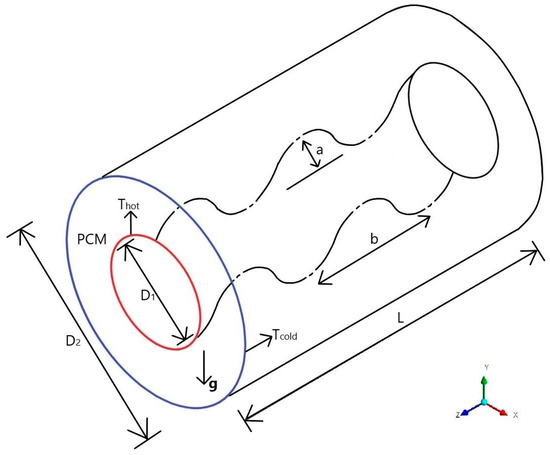
Figure 1.
Heat exchanger physical geometry with inner corrugated duct.

Table 1.
Dimensions of the physical model for different cases.
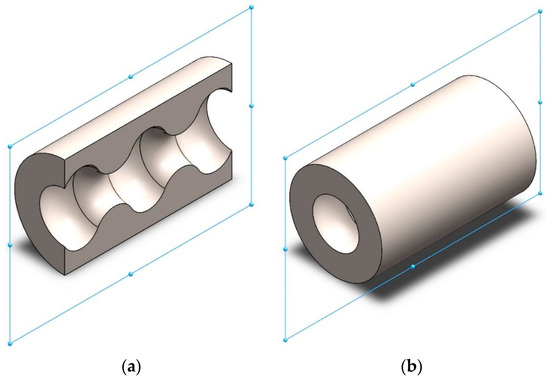
Figure 2.
(a) The heat exchanger’s midsection; (b) a solid model of the heat exchanger.
3. Governing Equations
The governing equations were written using three-dimensional equations. As a solver, the commercial ANSYS software is used to solve equations of continuity, momentum, and energy. Thermal radiation is not considered in this investigation. Equations are as follows:
In above equations, PCM’s enthalpy can be calculated as
The sensible enthalpy is denoted by (h), and the latent heat is denoted by (LH). Calculate the sensible enthalpy using the formula
In Equation (5), (href) is the reference enthalpy and (Cp) is the constant pressure specific heat. (∆LH) can be expressed as
In this case, (B) denotes the liquid fraction of PCM, which can be defined as
The liquid phase of PCM is assumed to be three-dimensional, time-dependent, laminar, Newtonian, and incompressible in the study’s numerical modeling. In the computational domain, heat is transported via conduction in the solid phase and convection in the liquid phase. During the phase transition, the change in PCM volume is disregarded. The Grashof number is as follows:
Prandtl number is
The Nusselt number is calculated according to the following formula (Çengel, 2019).
Rayleigh number is given in
3.1. Boundary Conditions
On the boundaries, all velocity numbers (vertical and horizontal) were set to zero, and the inner cylinder’s temperature was made to be higher than the outer cylinder’s temperature. Boundary walls were solid and impermeable. The inner cylinder was set to 25 degrees Celsius at a constant temperature, while the outside cylinder swung between 60 and 70 degrees Celsius depending on the temperature difference.
3.2. Solution Method
The above-mentioned governing equations with boundary and initial conditions are solved by using finite volume method (FVM). SIMPLE is selected for the pressure-velocity coupling. A second-order upwind scheme is used for momentum while third-order MUSCL is used for energy. As for the time dependent part, first-order implicit formulation is used. Under relation parameters, 0.3 for pressure, 0.2 for liquid fraction, and 0.5 for energy are considered. A convergence criterion of 10−7 is used.
3.3. Details on PCM
In this study, paraffin wax was chosen as the PCM to use in the system. Table 2 shows the thermal properties of the PCM.

Table 2.
Thermophysical properties for paraffin wax [20].
3.4. Grid Distribution
Figure 3 shows the grid distribution. For each of the examples analyzed, a different grid distribution is employed, as shown in Table 3. These are the ideal grid distribution values utilized in the calculations, as shown in the table.
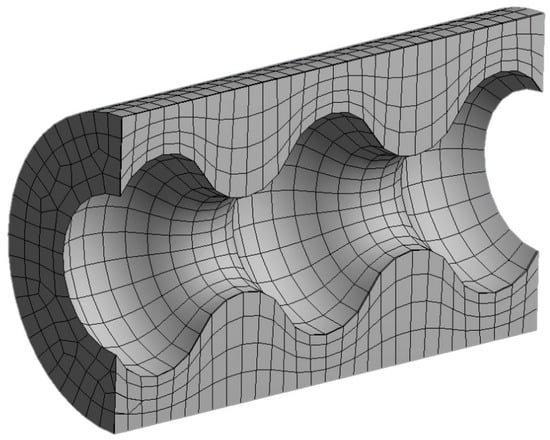
Figure 3.
Grid distribution for pipe progression.

Table 3.
Grid distribution.
3.5. Validation
The code is validated using the study’s literature to check if it is correct. As a result, Mahdi et al. [21] were selected for their research on the use of a double-pipe, helical-coiled tube as a novel and high-performance PCM containment design for latent heat thermal energy storage systems. The outcome, as shown in Figure 4, demonstrates that the works are equivalent.
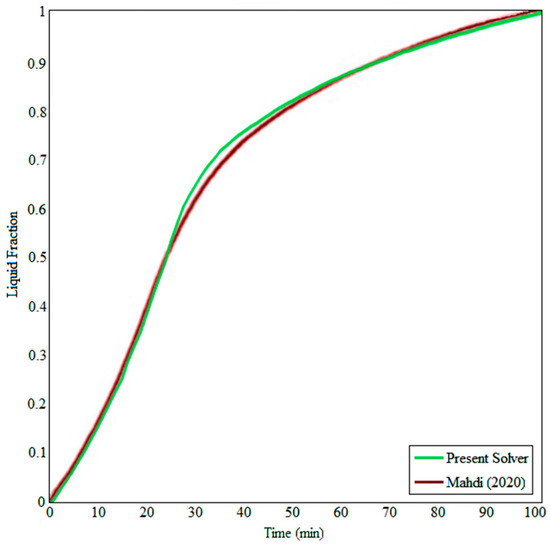
Figure 4.
Validation of the code through research [21].
4. Results and Discussion
A three-dimensional, time-dependent computational analysis on a melting problem through a duct with an inner sinusoidal pipe that is filled with PCM is studied in this work. In the analysis, different geometrical parameters (cases) are chosen with different temperature differences.
Figure 5 depicts the mass fraction for various temperature differences and time periods in various instances. Heat transfer is primarily accomplished by conduction for all temperature levels when the amount of liquid PCM is modest at the start. Surface waviness is an important parameter for melting and it shows the positive effects on melting time. Fully melting occurs on the top side of the wavy pipe except for the lowest value of temperature difference and Cases 1, 2, and 3. At the same temperature difference value, there is no unmelted PCM for Case 4. There is fully melted PCM is observed for ΔT = 60 °C for all cases. Additionally, waviness value has an important effect on melting time. The fundamental reason for this is that the convergent part of the water zone has a higher heat transmission surface area as well as the development of vortices, resulting in good fluid mixing and hence higher convection heat transfer.
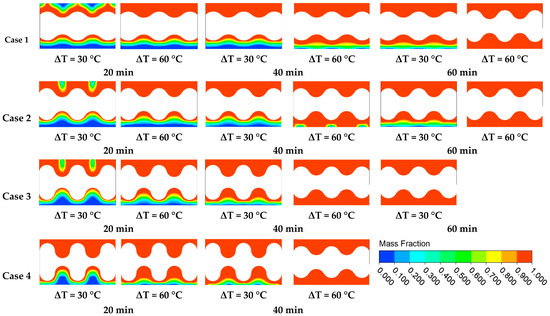
Figure 5.
Time-dependent mass fraction for various temperature differences for different cases.
Figure 6 illustrates the temperature distribution which is simulated via isotherms for the different time steps and temperature differences for different cases. It is noticed that temperature is constant for all heat exchanges at ΔT = 60 °C for all cases and 60 min. It means that all materials were melted in those conditions. The figure shows that the temperature started going to a higher degree for t = 20 min and ΔT = 30 °C from the top half side and reach constant temperature depends on the duration. On the contrary, the bottom half side of the heat exchanger has reached a constant temperature lately for all values of temperature difference. The main effective parameter on this is the studied cases.
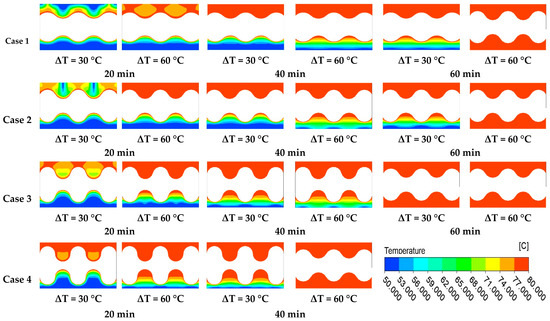
Figure 6.
Time-dependent temperature distribution for various temperature differences for different cases.
Streamlines are presented in Figure 7 with the same parameters as Figure 5 and Figure 6. Symmetrical flow distribution is formed inside the sinusoidal wavy wall and flat surface depending on temperature differences in the upper part. Different flow distributions are formed in different eyes. In some parts, there is a stagnant point. The shape of flow circulation changes with the changing of geometry.

Figure 7.
Streamline for various time steps and temperature differences for different cases.
The effect of the internal amplitude ratio on melting time for paraffin wax in the system is presented in Figure 8 for different cases and temperature differences. There is a linear increase up to 0.8 of the value of the melting and then a plateau is shown for almost all cases. As seen from the figure, the best result is formed for Case 4 and ∆T = 60 °C on behalf of melting time. Additionally, the worst results are shown for Case 1. It means that the geometrical design is extremely important to make passive control of the melting of the PCM. As the internal amplitude ratio increases, the phase change process becomes accelerated up to value of 0.8. This is attributed to the higher local velocities and enhanced thermal transport with higher internal amplitude ratios. At the highest amplitude ratio, the occurrence of large vortices in the PCM zone results in performance degradation. At time t = 40 min, the melt fraction amount is obtained as 0.82, 0.87, and 0.93 for amplitude ratios of 0.4, 0.6, 0.8. At ∆T = 30 °C, the phase completion time for Case C2 is 82.66 min, while increasing the temperature speeds up the process and the time for C6 at ∆T = 60 °C is observed as 44 min. There is a 46.77% reduction in the phase completion time as the temperature is increased to 60 °C for Case C2. At ∆T = 60 °C, when different Cases C6 and C7 are compared, the phase completion time is reduced by about 24.5%, which shows the favorable impacts of amplitude ratio at higher temperatures.
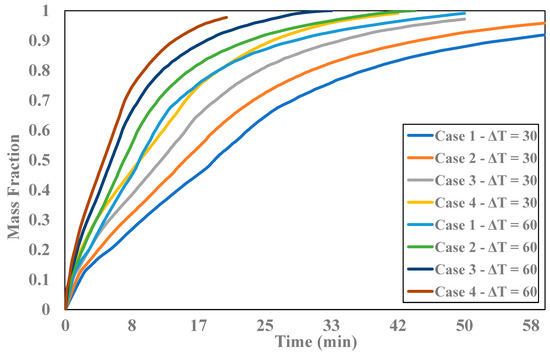
Figure 8.
Variation of mass fraction with time for different cases and temperature differences.
Two different points are chosen like a probe to measure temperature values. Based on these probes as shown in Figure 9, temperature values are presented in Figure 10 at point 1. As shown from the figure, temperature values are increased suddenly depending on the temperature difference; this increment turns out to be a linear increase and it becomes constant due to the phase change. As expected, higher temperature values are obtained for higher temperature differences. The highest temperature value is formed for Case 4 and the lowest one for Case 1 for all values of temperature difference for point 1 as shown in Figure 10. Temperature fluctuations are observed in the figure due to the beginning of the melting at that point and time-dependent heat transfer. If we look at the temperature variation through point 2, different temperature trends are shown with time due to unmelted phase change material inside the heat exchanger. At that point, again, the lowest temperature is shown in Case 1 but the temperature increases almost linearly with time and there is no constant value due to unmelted PCM.
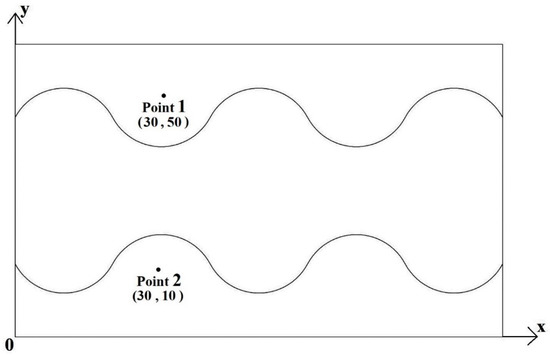
Figure 9.
Chosen points for temperature graphs.
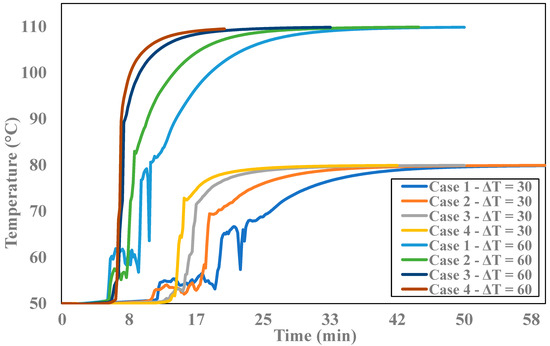
Figure 10.
Temperature profiles on point 1.
5. Conclusions
To simulate the melting of PCMs in a heat exchanger with a sinusoidally variable pipe insertion, a three-dimensional computer analysis was performed. The impact of temperature difference and shape on the melting time of PCM in the system was investigated. The choice of geometrical factors appears to be the most effective influence on melting time. Increasing the temperature difference increases the melting time, but different melting cases are obtained inside the heat exchanger. When the amplitude ratio increases, the phase transition becomes fast up to a value of 0.8. When Cases C2 and C6 are compared, a 46.77% reduction in the complete phase change process is achieved as the temperature is increased from 30 °C to 60 °C for Case C2. When Cases C6 and C7 are compared at 60 °C (amplitude ratio rises from 0.4 to 0.6), the phase completion time is reduced by about 24.5%. It means that passive control of melting can be done via adjusting of the geometry. In this work, four different geometrical ratios were tested and it was found that the best melting time is formed for Case 4 and the worst one for Case 1 for all values of temperature difference.
Author Contributions
Conceptualization, H.F.Ö. and F.S.; methodology, Ö.A.; software, Ö.A.; validation, H.F.Ö., Ö.A. and F.S; formal analysis, N.H.A.-H.; investigation, N.H.A.-H.; resources, N.H.A.-H.; data curation, F.S.; writing—original draft preparation, H.F.Ö.; writing—review and editing, F.S.; visualization, Ö.A.; supervision, N.H.A.-H.; project administration, N.H.A.-H.; funding acquisition, N.H.A.-H. All authors have read and agreed to the published version of the manuscript.
Funding
This research received no external funding.
Informed Consent Statement
Not applicable.
Data Availability Statement
Not applicable.
Conflicts of Interest
The authors declare no conflict of interest.
Nomenclature
| B | liquid fraction |
| Cp | heat capacity, J/kgK |
| gravity, m/s2 | |
| H | length of cavity, m |
| total enthalpy, J | |
| h | length of PCM, m |
| specific enthalpy, J/kg | |
| thermal conductivity, W/mK | |
| L | length of cavity, m |
| l | length of PCM, m |
| h | sensible enthapy, J/kgK |
| LH | enthalpy, J/kgK |
| local Nusselt number | |
| average Nusselt number | |
| P | pressure, N/m2 |
| Pr | Prandtl number |
| Ra | Reighley number |
| source term | |
| temperature, K | |
| time, s | |
| u | velocity, m/s |
| Greek letters | |
| thermal diffusivity, m2/s | |
| thermal expansion coefficient, 1/K | |
| dynamic viscosity, Pa.s | |
| ν | kinematic viscosity, m2/s |
| density, kg/m3 | |
| Abbreviations | |
| FVM | finite volume method |
| HT | heat transfer |
| PCM | phase change materiel |
| Subscript | |
| c | cold |
| h | hot |
| s | solid |
| l | liquid |
References
- Dormohammadi, R.; Farzaneh-Gord, M.; Ebrahimi-Moghadam, A.; Ahmadi, M.H. Heat transfer and entropy generation of the nanofluid flow inside sinusoidal wavy channels. J. Mol. Liq. 2018, 269, 229–240. [Google Scholar] [CrossRef]
- Harikrishnan, S.; Tiwari, S. Heat transfer characteristics of sinusoidal wavy channel with secondary Corrugations. Int. J. Therm. Sci. 2019, 145, 105973. [Google Scholar] [CrossRef]
- Aliabadi, M.K. Influence of different design parameters and Al2O3-water nanofluid flow on heat transfer and flow characteristics of sinusoidal-corrugated channels. Energy Convers. Manag. 2014, 88, 96–105. [Google Scholar] [CrossRef]
- Asadi, A.; Nezhad, A.H.; Sarhaddi, F.; Keykha, T. Laminar ferrofluid heat transfer in presence of non-uniform magnetic field in a channel with sinusoidal wall: A numerical study. J. Magn. Magn. Mater. 2019, 471, 56–63. [Google Scholar] [CrossRef]
- Shahsavar, A.; Al-Rashed, A.A.; Entezari, S.; Sardari, P. Melting and solidification characteristics of a double-pipe latent heat storage system with sinusoidal wavy channels embedded in a porous medium. Energy 2019, 171, 751–769. [Google Scholar] [CrossRef]
- Tang, W.; Hatami, M.; Zhou, J.; Jing, D. Natural convection heat transfer in a nanofluid-filled cavity with double sinusoidal wavy walls of various phase deviations. Int. J. Heat Mass Transf. 2017, 115, 430–440. [Google Scholar] [CrossRef]
- Dong, X.; Chen, W.; Cheng, Q.; Liu, Y.; Dai, H. Numerical analysis of thermal-hydraulic characteristics of steam-air condensation in vertical sinusoidal corrugated tubes. Int. J. Heat Mass Transf. 2021, 164, 120558. [Google Scholar] [CrossRef]
- Manjunath, M.; Karanth, K.V.; Sharma, N.Y. Numerical investigation on heat transfer enhancement of solar air heater using sinusoidal corrugations on absorber plate. Int. J. Mech. Sci. 2018, 138–139, 219–228. [Google Scholar] [CrossRef]
- Chu, W.X.; Sheu, W.; Hsu, C.; Wang, C. Airside performance of sinusoidal wavy fin-and-tube heat exchangers subject to large-diameter tubes with round or oval configuration. Appl. Therm. Eng. 2020, 164, 114469. [Google Scholar] [CrossRef]
- Modi, A.J.; Rathod, M. Comparative study of heat transfer enhancement and pressure drop for fin-and-circular tube compact heat exchangers with sinusoidal wavy and elliptical curved rectangular winglet vortex generator. Int. J. Heat Mass Transf. 2019, 141, 310–326. [Google Scholar] [CrossRef]
- Ren, Q. Enhancement of nanoparticle-phase change material melting performance using a sinusoidal heat pipe. Energy Convers. Manag. 2019, 180, 784–795. [Google Scholar] [CrossRef]
- Kurtulmus, N.; Zontul, H.; Sahin, B. Heat transfer and flow characteristics in a sinusoidally curved converging-diverging channel. Int. J. Therm. Sci. 2020, 148, 106163. [Google Scholar] [CrossRef]
- Goodarzi, M.; Mazharmanesh, S. Heat transfer enhancement in parallel-plate double-pass heat exchanger using sinusoidal separating plate. Int. J. Therm. Sci. 2013, 72, 115–124. [Google Scholar] [CrossRef]
- Li, Z.; Shahsavar, A.; Niazi, K.; Al-Rashed, A.A.; Rostami, S. Numerical assessment on the hydrothermal behavior and irreversibility of MgO-Ag/water hybrid nanofluid flow through a sinusoidal hairpin heatexchanger. Int. Commun. Heat Mass Transf. 2020, 115, 104628. [Google Scholar] [CrossRef]
- Kang, H.; Han, U.; Lim, H.; Lee, H.; Hwang, Y. Numerical investigation and design optimization of a novel polymer heat exchanger with ogive sinusoidal wavy tube. Int. J. Heat Mass Transf. 2021, 166, 120785. [Google Scholar] [CrossRef]
- Ho, C.; Hsien, T.; Chang, H.; Tu, J.-W.; Yang, C. The influences of recycle on a double-pass laminar counterflow concentric-tube heat exchangers with sinusoidal wall fluxes. Int. Commun. Heat Mass Transf. 2009, 36, 579–584. [Google Scholar] [CrossRef]
- Hong, Y.; Du, J.; Li, Q.; Xua, T.; Li, W. Thermal-hydraulic performances in multiple twisted tapes inserted sinusoidal rib tube heat exchangers for exhaust gas heat recovery applications. Energy Convers. Manag. 2019, 185, 271–290. [Google Scholar] [CrossRef]
- Moawed, M.; Ibrahim, E.; Gomaa, A. Thermal performance of a pipe in pipe heat exchanger with sinusoidal inner pipe. Energy Convers. Manag. 2008, 49, 678–686. [Google Scholar] [CrossRef]
- Akbal, Ö.; Öztop, H.F.; Abu-Hamdeh, N.H. Three-dimensional computational study in a corrugated pipe inserted system filled with phase change material. Int. J. Numer. Methods Heat Fluid Flow 2021. ahead-of-print. [Google Scholar] [CrossRef]
- Abu-Hamdeh, N.H.; Akbal, Ö.; Öztop, H.F.; MAbusorrah, A.; Bayoumi, M.M. A three-dimensional computational analysis of ellipsoidal radiator with phase change. Int. J. Numer. Methods Heat Fluid Flow 2021, 31, 2072–2087. [Google Scholar] [CrossRef]
- Mahdi, M.S.; Mahood, H.; Mahdic, J.; Khadom, A.; Campbell, A. Improved PCM melting in a thermal energy storage system of double-pipe helical-coil tube. Energy Convers. Manag. 2020, 203, 112238. [Google Scholar] [CrossRef]
Disclaimer/Publisher’s Note: The statements, opinions and data contained in all publications are solely those of the individual author(s) and contributor(s) and not of MDPI and/or the editor(s). MDPI and/or the editor(s) disclaim responsibility for any injury to people or property resulting from any ideas, methods, instructions or products referred to in the content. |
© 2023 by the authors. Licensee MDPI, Basel, Switzerland. This article is an open access article distributed under the terms and conditions of the Creative Commons Attribution (CC BY) license (https://creativecommons.org/licenses/by/4.0/).